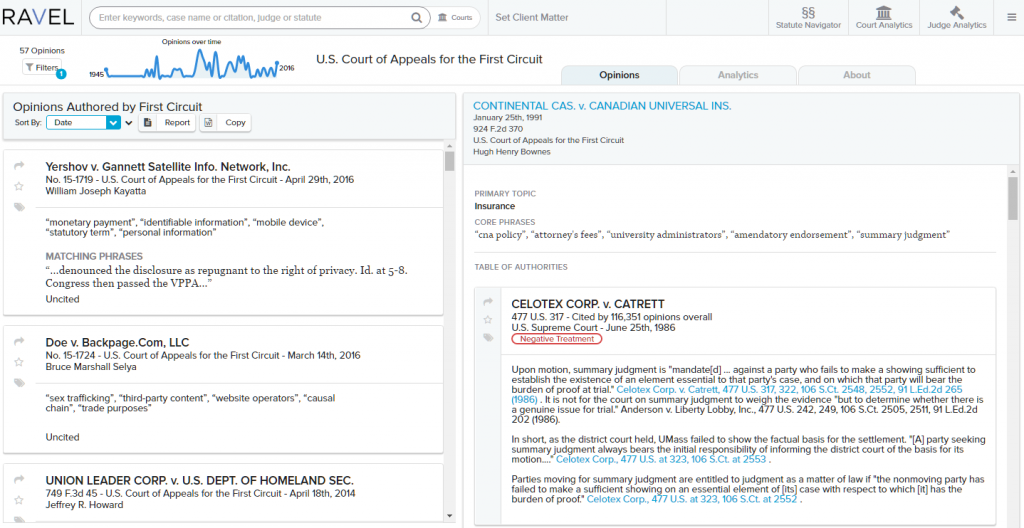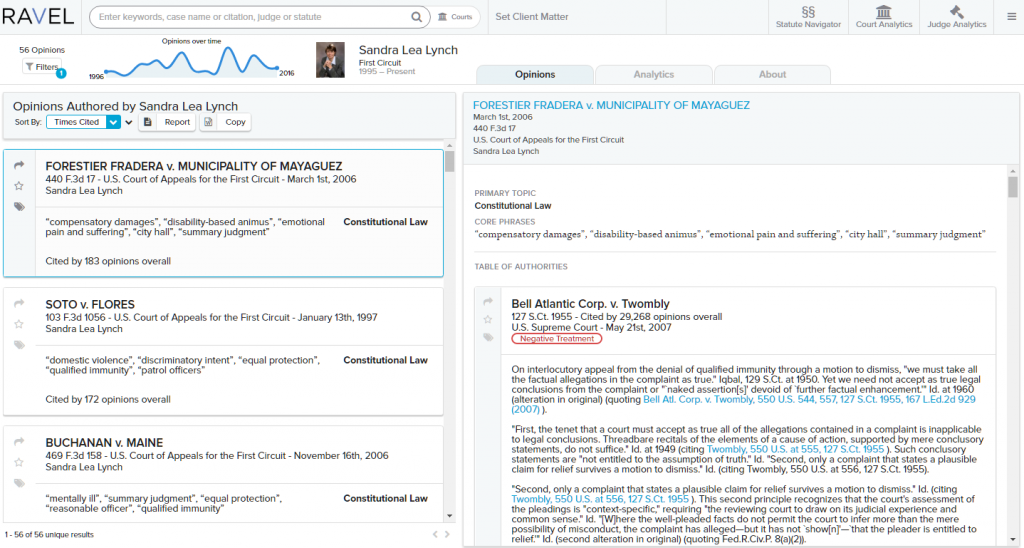The legal research service Ravel Law, which last year launched Judge Analytics to provide analysis of how individual federal court judges make decisions, today is launching Court Analytics, a similar feature that applies analytics to an entire court, including all its cases and judges.
(For more on Ravel Law’s Judge Analytics, see my posts here and here.)
With Court Analytics, you can see, for example, a court’s most-cited opinions and judges, as well as the opinions and courts it most frequently cites. It also lets you identify how courts and judges have ruled in the past on particular issues or motion types.
Court Analytics includes the ability to apply filters by motion types, keywords, topics and date ranges. There are a number of predefined filters by topics of law and motion types, but you can also enter any keyword to apply it as a filter.
To use Court Analytics, you begin by selecting a court. Thank’s to Ravel’s digitization partnership with Harvard Law School, its case law collection includes all federal and state courts. (Go here for a full description of Ravel’s court and date coverage.)
Once you select a court, you come to a page showing its opinions arranged by how many times they’ve been cited. In the 1st U.S. Circuit Court of Appeals, for example, the most-cited case is U.S. v. Zannino, 895 F.2d 1 (1990), which has been cited by 1,476 opinions.
I can move away from this opinions view by selecting a tab labeled Analytics. This gives me three sets of analytics:
- Opinions, showing the opinions — from whatever court — that the 1st Circuit most frequently cites in its own opinions.
- Courts, showing the courts that the 1st Circuit most frequently cites. As you might expect, it most frequently cites itself, followed by the Supreme Court, the 9th Circuit and the 5th Circuit.
- Judges, showing the judges whose opinions are most frequently cited by the 1st Circuit.
A third tab, About, brings up a list of sitting and retired judges from the court. Select any judge to bring up the same types of analytics discussed above — most-frequently cited opinions of that judge and the opinions, courts and judges that judge most frequently cites.
At any point using any of these analytics, you can apply any of the various filters or multiple filters. If you want to see how a judge or a court has ruled on employment law matters, select that filter to show only those cases.
How would an attorney use these analytics? I put that question last week to Daniel Lewis, the co-founder and chief executive officer of Ravel Law. He described two primary use cases:
- Forum comparison. If an attorney is forum shopping and wants to compare how different jurisdictions have dealt with a particular issue or motion.
- Argument crafting. If an attorney is arguing a matter to a court, the argument can be made more persuasive by knowing which authorities that court or judge finds most persuasive.
“Attorneys will be able to use it to see how a court has dealt with cases on a particular topic or motion, what they key cases are they should know about, and the particular rules, standards and language that are most important in that venue,” Lewis said.
Although basic access to Ravel Law is free, its Court Analytics and Judge Analytics features are available only to paid subscribers. Ravel does not publish its pricing on its website but requires customers to call for information on subscription plans.
Later today, Ravel will be hosting a launch webcast to share more details about Court Analytics. The webcast is today (Dec. 5, 2016) at 2 p.m. Eastern time. Register here.
 Robert Ambrogi Blog
Robert Ambrogi Blog
